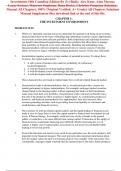Tentamen (uitwerkingen)
Solutions Manual for Investments 10th Canadian Edition By Zvi Bodie, Alex Kane, Alan Marcus, Lorne Switzer, Maureen Stapleton, Dana Boyko, Christine Panasian (All Chapters, 100% Original Verified, A+ Grade)
- Vak
- Instelling
This Is Original 10th Edition of Solutions Manual From Original Author. All Other Files in the market are fake/old Edition. Other Sellers Have changed old Edition Number to new But solutions Manual is old Edition. Solutions Manual for Investments 10th (Canadian Edition) By Zvi Bodie, Alex Kane, ...
[Meer zien]



